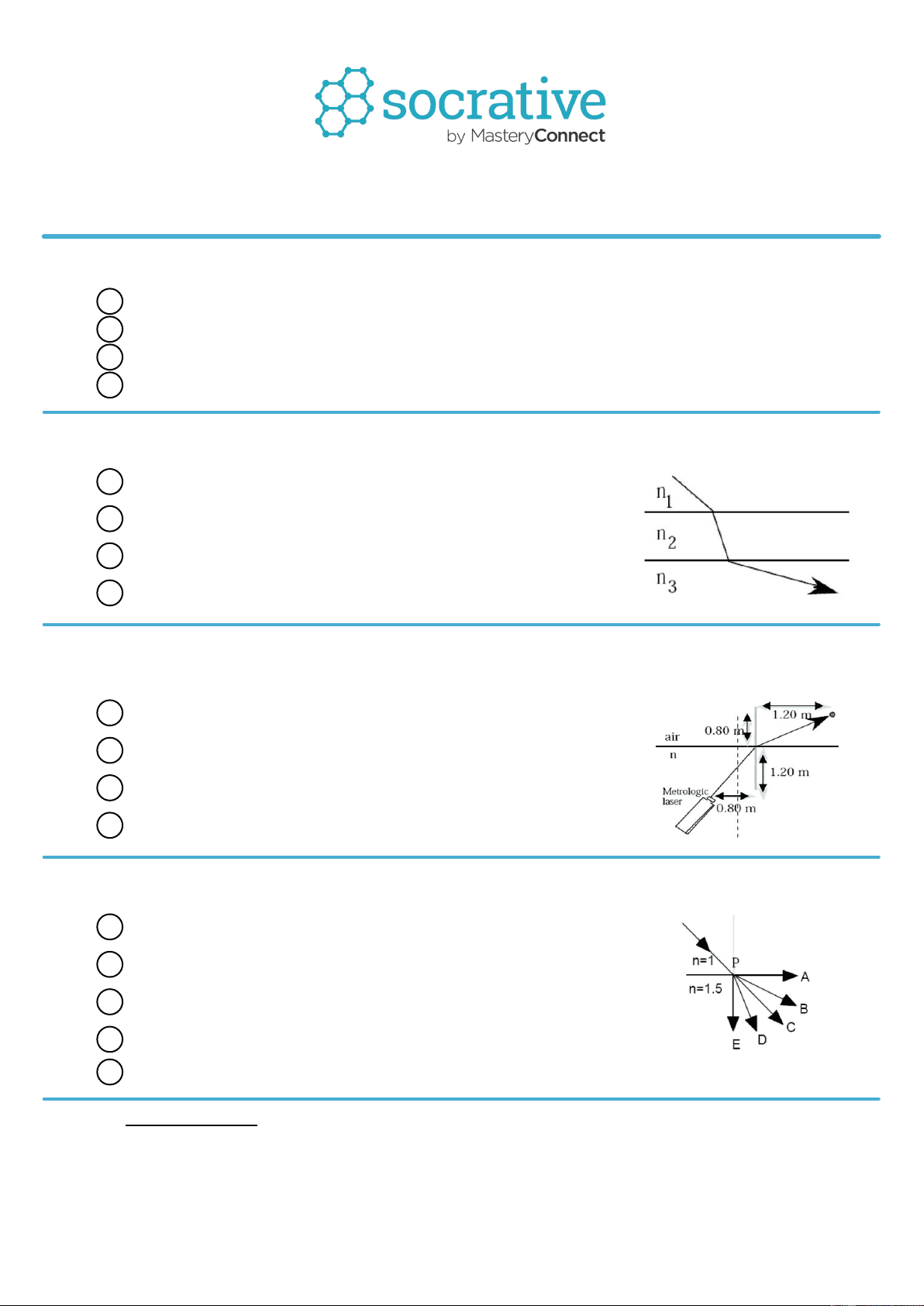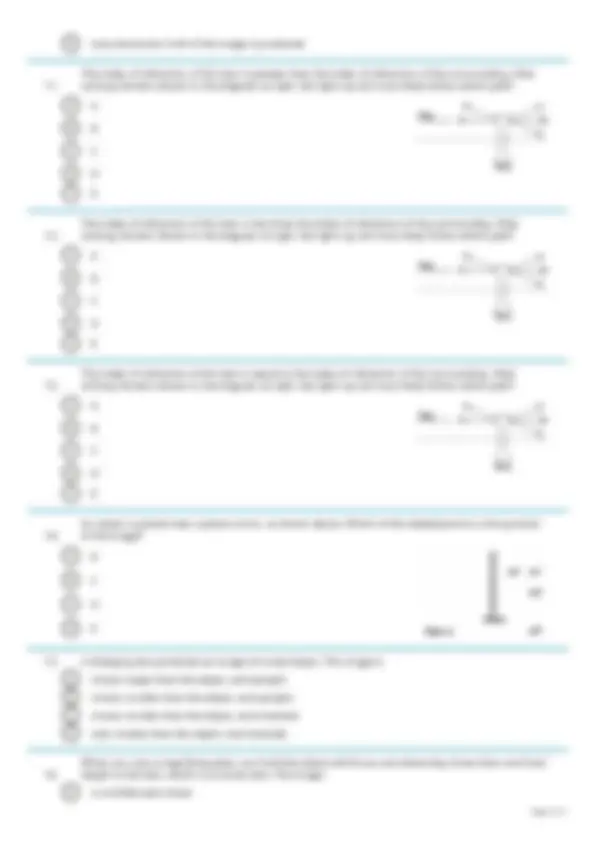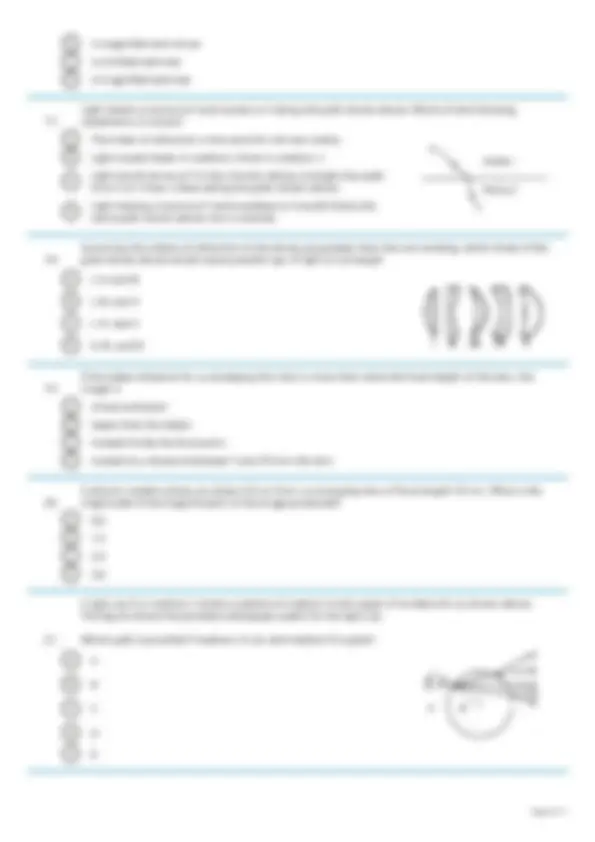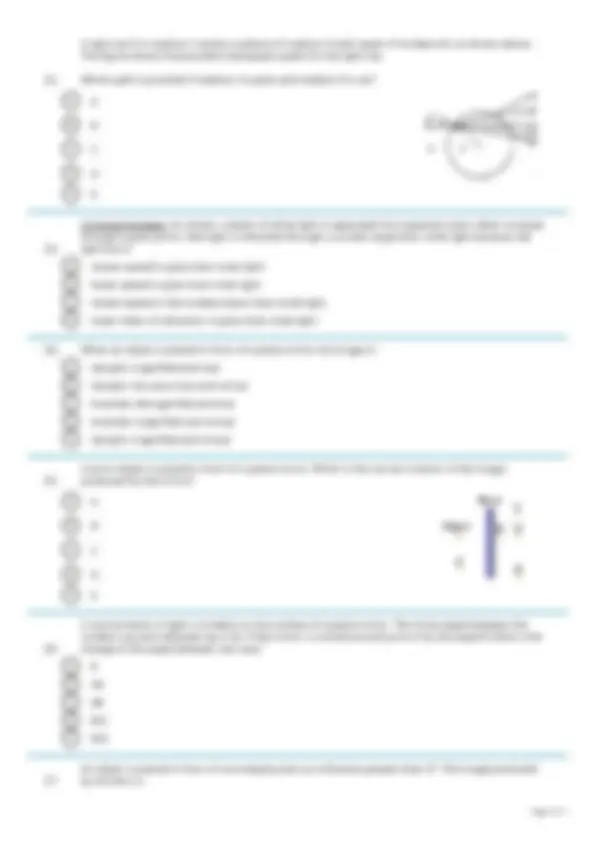





Study with the several resources on Docsity

Earn points by helping other students or get them with a premium plan


Prepare for your exams
Study with the several resources on Docsity

Earn points to download
Earn points by helping other students or get them with a premium plan
Community
Ask the community for help and clear up your study doubts
Discover the best universities in your country according to Docsity users
Free resources
Download our free guides on studying techniques, anxiety management strategies, and thesis advice from Docsity tutors
Quiz name: AP Physics 2 - Test 08 - Ray Optics Pt. 1. 1. An object is located 0.20 meters from a converging lens which has a focal length of 0.15 meters.
Typology: Exercises
1 / 7

This page cannot be seen from the preview
Don't miss anything!




An object is located 0.20 meters from a converging lens which has a focal length of 0.15 meters. Relative to the object, the image formed by the lens will be: A (^) virtual, inverted, smaller B (^) real, inverted, smaller. C (^) real, inverted, larger D (^) virtual, upright, larger
A beam of light passes from medium 1 to medium 2 to medium 3 as shown in the accompanying figure. What is true about the respective indices of refraction (n 1 , n 2 , and n 3 )
A (^) n 1 > n 2 > n 3 B (^) n 1 > n 3 > n 2 C (^) n 2 > n 3 > n 1 D (^) n 2 > n 1 > n 3
A laser is embedded in a material of index of refraction n. The laser beam emerges from the material and hits a target. See the accompanying figure for the position parameters of the laser and target. The value of n is:
A (^) 1.
B (^) 1.
C (^) 2.
A beam of light is directed toward point P on a boundary as shown to the right. Which segment best represents the refracted ray?
A (^) PA
B (^) PB
C (^) PC
2 Correct Answers: Which of the following are possible for the images formed by the lens in the accompanying figure? Select two answers.
A (^) Real and inverted
B (^) Real and smaller in size
C (^) Real and upright
D (^) Virtual and smaller in size
A narrow beam of monochromatic light enters a lens parallel to the optic axis, as shown in the accompanying diagram. Which arrow best represents the direction of the light after leaving the lens?
A (^) A
B (^) B
C (^) C
D (^) D
E (^) E
Which diagram best represents what happens to a ray of light entering air from water? Air is at the top in all diagrams. A (^) A B (^) B C (^) C D (^) D
A beam of light traveling in glass (ng = 1.5) strikes a boundary with air (na = 1.0) at point P. The angle of incidence is 60° as shown in the diagram. Which ray would best indicate the beam’s path after point P?
A (^) A
B (^) B
C (^) C
D (^) D
E (^) E
2 Correct Answers: A small light bulb is placed 20 cm to the right of a converging lens of focal length 10 cm. Which of the following statements are true about the image of the bulb formed by the lens? Select two answers. A (^) It is virtual B (^) It is inverted C (^) It is one-half the size of the bulb D (^) It is 20 cm to the left of the lens
An image is formed on a screen by a convergent lens. If the top half of the lens is then covered what will happen to the image? A (^) the image is dimmer but otherwise unchanged B (^) the image becomes half as big C (^) only the top half of the image is produced
B (^) is magnified and virtual C (^) is minified and real D (^) in magnified and real
Light leaves a source at X and travels to Y along the path shown above. Which of the following statements is correct? A (^) The index of refraction is the same for the two media. B (^) Light travels faster in medium 2 than in medium 1.
C Light would arrive at Y in less time by taking a straight line path from X to Y than it does taking the path shown above.
D Light leaving a source at Y and traveling to X would follow the same path shown above, but in reverse.
Assuming the indices of refraction of the lenses are greater than the surrounding, which three of the glass lenses above would cause parallel rays of light to converge? A (^) I, II, and III
B (^) I, III, and V
C (^) I, IV, and V
D (^) II, III, and IV
If the object distance for a converging thin lens is more than twice the focal length of the lens, the image is A (^) virtual and erect B (^) larger than the object C (^) located inside the focal point D (^) located at a distance between f and 2f from the lens
A physics student places an object 6.0 cm from a converging lens of focal length 9.0 cm. What is the magnitude of the magnification of the image produced? A (^) 0. B (^) 1. C (^) 2. D (^) 3.
A light ray R in medium I strikes a sphere of medium II with angle of incidence θ, as shown above. The figure shows five possible subsequent paths for the light ray.
Which path is possible if medium I is air and medium II is glass?
A (^) A
B (^) B
C (^) C
A light ray R in medium I strikes a sphere of medium II with angle of incidence θ, as shown above. The figure shows five possible subsequent paths for the light ray.
Which path is possible if medium I is glass and medium II is air?
A (^) A
B (^) B
C (^) C
D (^) D
E (^) E
2 Correct Answers: As shown, a beam of white light is separated into separate colors when it passes through a glass prism. Red light is refracted through a smaller angle than violet light because red light has a: A (^) slower speed in glass than violet light B (^) faster speed in glass than violet light C (^) slower speed in the incident beam than violet light D (^) lower index of refraction in glass than violet light
A (^) Upright, magnified and real B (^) Upright, the same size and virtual C (^) Inverted, demagnified and real D (^) Inverted, magnified and virtual E (^) Upright, magnified and virtual
A point object is placed in front of a plane mirror. Which is the correct location of the image produced by the mirror?
A (^) A
B (^) B
A narrow beam of light is incident on the surface of a plane mirror. The initial angle between the incident ray and reflected ray is 2α. If the mirror is turned around point A by the angle θ what is the change of the angle between two rays? A (^) θ B (^) 2θ C (^) 4θ D (^) θ/ E (^) θ/
An object is placed in front of a converging lens at a distance greater than 2F. The image produced by the lens is:
A (^) 0.5 m
B (^) 1.0 m
C (^) 2.0 m
D (^) 4.0 m
A group of students collected data using a lens. They varied the distance so of an object from the lens and measured the image distance si. The figure above is their graph of the inverse of the image distance as a function of the inverse of the object distance.
What is the magnitude of the image's magnification when the object is placed 2 m from the lens? A (^) 1/
B (^1)
C (^3)
D The magnification is undefined because the image is an infinite distance from the lens.
A light ray enters a layer of water at point X, passes through a layer of glass, and exits through a layer of air at point Y, as shown in the figure. Where would the ray exit the layer of air if the glass was replaced with a material of lower index of refraction? Assume no total internal reflection occurs. A (^) At a point above point Y
B (^) At a point below point Y
C (^) At point Y
D The location cannot be determined without knowing how much lower the index of refraction of the new material is.
A (^) in a vacuum B (^) through water C (^) through glass D (^) through diamond E (^) through air
A (^) is less than 1 B (^) is greater than 1 C (^) is equal to 1 D (^) could be any of the given answers, it all depends on optical density
A ray of light, which is traveling in air, is incident on a glass plate at a 45 degree angle. The angle of refraction in the glass. A (^) is less than 45 B (^) is greater than 45 C (^) is equal to 45 D (^) could be any of the above